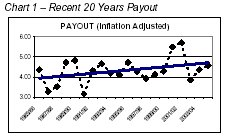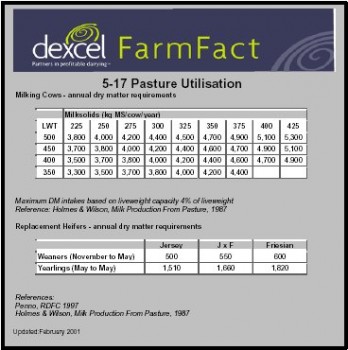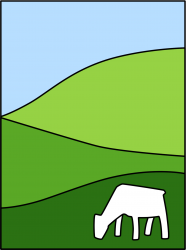The Compelling Reason to have Dairy Replacements Grown Away from the Dairy Farm.
by Ian Wickham. March 2006
Historically dairy farmers would NOT send their dairy replacements to another property to be grown for two main reasons:
- They figured that they could grow them at home cheaper.
- They did not trust anyone else to look after them as well as they could.
Currently it appears about 90% of dairy replacements are grown away from the dairy unit, with most being under another person's management.
If reason 2 has been satisfied, how does current figuring stack up on reason 1?
Has a compelling factor driven this change?
We often hear a dairy farmer say “The payout of Milksolid has (or ‘is going to’) come down, – I’ll have to bring my heifers home and graze them cheaper!” How valid is this statement?

Firstly; While the Inflation Adjusted Payout has always fluctuated, the trend has been a significant increase during the past 20 years. (see Chart 1)
Secondly; I think the farmer above is not so much looking for ‘cheap grazing’ as not recognising the difference in value of grazing at home compared to that of purchased grazing.
Valuing Replacements
There are many methods a dairy farmer can use to value the cost of dairy replacements about to enter his lactating herd.
It depends on the purpose of the exercise as to which method is more suitable. For example…..
One method is an ‘Open Market Value’ meaning the amount that each animal would cost to purchase at a particular time based on actual sales.
This is the system the Inland Revenue Department requires for tax income purposes. A local market does of course exist for dairy replacements. More recently the values are tending to be more ‘international’ with exporters paying a higher price than the domestic market.
In fact few dairy operators in NZ actually purchase heifers on the open market, much preferring to follow the conventional practice of using AB to generate replacements from their existing herd.
Cost Accounting
This means that most dairy farmers are likely to use some form of a ‘cost accounting’ method, broadly meaning they value their replacements on how much each animal actually costs them.
These costs are expended in two main ways:
a) Cash expenses – These are amounts your accountant sees and records. They include;
- AB & breeding expenses in excess of what it would cost just to get the herd pregnant.
- Calf rearing expenses – bought milk and feed, Vet costs, deaths, rearing facility & labour labour.
b) Lost opportunity expenses – Not seen by your accountant and include;
- Calves not sold.
- Calf milk not sold.
- Labour diverted to calf rearing and husbandry of the young stock.
- And the BIG ONE – the feed consumed by the heifer up until herd entry.
The Value of Dry Matter
Putting heifers out to graze is the same principle as buying in more feed for the lactating dairy herd.
If we accept that premise, then we can compare the expense of ‘grazing-off’ with the value of the extra feed available to the dairy herd and the extra income that will generate.
Cents per Kg Dry Matter (DM) is an accepted way of comparing values (with adjustments for M.E. values if need be). How much DM should a Friesian heifer consume May to May?

Refer to Dexcel Farm Fact 5-17 and we see 1,820 kg DM or an average of 5 kg DM per day or 35 kg DM per week.
At NZ Grazing, we find this to be insufficient to reach our liveweight targets.
At a recent Grasslands Conference field day, an estimate was 8 kg DM per day for the 12 month year ending 30th April when the heifer is about 21 months of age.
Within the industry we assume that the feed allocated to heifers ranges from 5 kg DM/day to 8 kg DM/day on different farms. (This is a range from 1,825 kg DM per year to 2,920 kg DM per year.)
| Kg of DM per day |
Grazing fee per week | ||||
|---|---|---|---|---|---|
| $6.00 | $6.50 | $7.00 | $7.50 | $8.00 | |
| 5.0 | $0.17 | $0.19 | $0.20 | – | – |
| 5.5 | $0.16 | $0.17 | $0.18 | $0.19 | – |
| 6.0 | $0.14 | $0.15 | $0.17 | $0.18 | $0.19 |
| 6.5 | $0.13 | $0.14 | $0.15 | $0.16 | $0.18 |
| 7.0 | $0.12 | $0.13 | $0.14 | $0.15 | $0.16 |
| 7.5 | – | $0.12 | $0.13 | $0.14 | $0.15 |
| 8.0 | – | $0.12 | $0.13 | $0.13 | $0.14 |
The price of grazing fees in terms of dollars per week range from $6.00 to $8.00 per week.
At first glance, one would think that $8.00 per week is more expensive grazing than $6.00 per week.
However, by referring to the table on the right, it is obvious that more feed used keeps the price per kg DM at a very economic level – say 14 cents!
Value of DM on Dairy Farms
Also in Dexcel Farm Fact 5-17 is a table for Milking Cows – annual dry matter requirements. A perusal of this table quickly shows that for any given liveweight cow, an increase of 200 kg DM will return an extra 25 kilograms of Milksolid.
Keep this simple and value a kg of MS at $4.00.
25 kg of MS at $4 equals $100.00. Therefore $100 divided by 200 kg of DM equals 50 cents a kg DM.
By removing replacements from a dairy unit, it allows all the feed grown on that unit to be given to a current dairy herd which will generate income at the rate of 50 cents kg DM.
If this can be gained by paying up to 20 cents kg DM for feed someone else is supplying to the dairy replacements – then the decision is a ‘no-brainer’!
But wait – There's More!
An even better reason to off-farm grow your replacements is the opportunity to enter into an agreement that GUARANTEES to achieve recommended target weights that most heifers in NZ do not currently achieve.
Look again at the table of prices based on cents per kg Dry Matter, and note the lower cost per kg DM of heifers eating more feed. These higher feed intakes are required to achieve higher liveweight targets.
By having a GUARANTEED liveweight, it is guaranteed that the heifer must have consumed the required amount of feed.
Some agreements are incentive based, but only NZ Grazing Co. Ltd offers Guaranteed target agreements.
Discussion
In years gone by there used to be much discussion on the methodology of calculating the economics of grazingoff’ the May to May heifers.
Factors discussed where things like;
- Buying more cows to eat the extra grass.
- More labour required to milk a larger herd.
- New cowshed needed.
- More capital needed.
- The herd walking further to pasture.
- No heifers to control rank grass or clean up the gullies!
- “I like seeing the heifers each day”.
That last factor I find hard to argue with, but most of the other arguments now seem almost quaint in light of the universal acceptance of ‘grazingoff’ of dairy replacements.
Lowered Milksolid Payout?
The value of the NZ dollar would have to be described as ‘volatile’ and we all know what that does to export product prices.
Additionally, the international price of dairy product is cyclical.
With these two factors combining, one can expect some seasons where the milksolid payout will be less than a previous season.
Presume that the milksolid payout was as low as $3.60 – should one “bring the heifers home”?
If one accepts that all the feed grown on the ‘dairy platform’, is able to be fed to the current herd and that this increased feed will increase milksolid production with no net increase in costs, and that it takes say 2,500 kg of DM to grow a replacement from a weaner in November to May 18 months later
– and the difference in DM value is say 25 cents.
– THEN this calculates at income lost of $625 per replacement or over $30,000 for 50 replacements if they were all returned home to be grown and thereby taking feed away from the milking herd.
